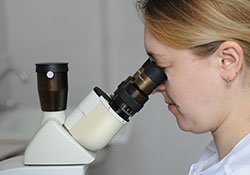Surveillance and lab network

WHO
Networks of clinicians, epidemiologists and virologists working in the WHO European Region routinely conduct surveillance of mild and severe disease due to influenza in order to:
- inform national influenza prevention and control programmes about the severity and impact of seasonal epidemics;
- identify the circulating influenza virus strains; and
- detect any emerging (zoonotic and pandemic) influenza viruses.
Coordination and dissemination of surveillance data
WHO/Europe and the European Centre for Disease Prevention and Control (ECDC) coordinate the collection and analysis of influenza surveillance data that are provided by Member States through designated laboratories (national influenza centres – NICs) and a national influenza focal point for epidemiological surveillance in each country.
The surveillance data are presented in Flu News Europe, the joint ECDC-WHO/Europe influenza surveillance bulletin, which describes and comments on influenza activity in the 53 Member States of the European Region, providing weekly updates for public health specialists, clinicians and the public on the timing of the influenza season, the spread of influenza, the prevalence and characteristics of circulating viruses (type, subtype and lineage, resistance to antiviral drugs) and their severity. In addition, these data are shared with WHO headquarters, contributing to the biweekly global influenza update.
Surveillance data from European Union/European Economic Area countries are also presented by the European Centre for Disease Control and Prevention (ECDC) in its Weekly Influenza Surveillance Overview (WISO).
Strengthening surveillance
WHO/Europe supports Member States’ efforts to strengthen their surveillance systems by providing:
- guidance and standards for influenza surveillance;
- technical support during outbreaks;
- training and professional development;
- laboratory diagnostic kits, reagents and supplies and external quality assessment programmes for national influenza centres;
- support in the selection of influenza strains for vaccine production; and
- by organizing annual meetings for national influenza surveillance focal points.
WHO Global Influenza Surveillance and Response System (GISRS)
NICs in the WHO European Region (the regional influenza laboratory network) are part of the GISRS, a global partnership of:
- 141 NICs in 111 countries;
- 6 WHO H5 reference laboratories;
- 5 WHO collaborating centres for reference and research on influenza (WHO CCs);
- a WHO collaborating centre for studies on the ecology of influenza in animals; and
- 4 WHO essential regulatory laboratories (WHO ERLs).
Within this global partnership, NICs conduct year-round surveillance of influenza, collect and test clinical specimens in their respective countries and share influenza viruses with WHO CCs, enabling WHO to analyse influenza virus surveillance data and recommend the composition of the influenza vaccine for the following flu season (once a year in the northern and once a year in the southern hemisphere). In addition, the collaborating centres determine the patterns of antiviral susceptibility of circulating strains and provide laboratory protocols and updated reagents.
The GISRS also acts as a global alert mechanism for the appearance of influenza viruses with pandemic potential, the sharing of which is governed by the terms of the Pandemic Influenza Preparedness (PIP) Framework adopted at the Sixty-fourth World Health Assembly in May 2011. The main objective of the PIP Framework is to improve pandemic influenza preparedness and response, by strengthening the GISRS particularly in those Member States with the greatest need.



